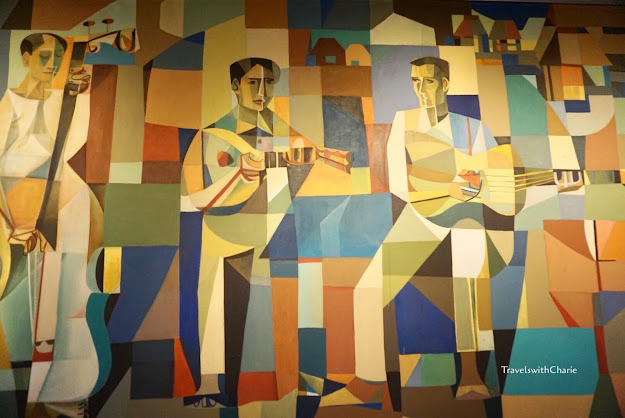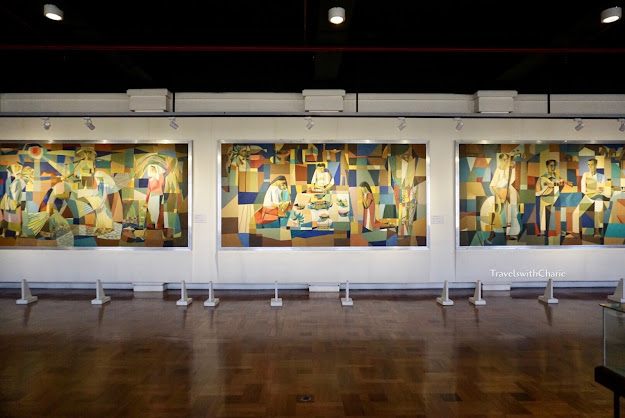Pamilya (Family)
With the completion of their new headquarters in Manila in 1961, PhilAm Life (a life insurance company) commissioned Vicente Silva Manansala to do a series of paintings for their cafeteria. (Lucky employees!) Before long these seven large-scale paintings about Philippine village life were moved to the front lobby which was deemed a more appropriate setting for the canvases. They remained there until the building was sold in 2012. Mindful of the cultural significance of the paintings and the need for its preservation and conservation, the management of PhilAm Life decided to loan these treasures to the National Museum in 2014.
“Pamilya reflects Filipino values of family solidarity and solemnity showing a common scenario of praying before sharing a meal with one’s family.” National Museum of the Philippines
One of the Thirteen Moderns and Neo Realists, Vicente Silva Manansala had the good fortune to study art in Canada, the United States, France and Switzerland through a number of grants he received from UNESCO, the French government and the U.S. State Department. He studied at the Ecole de Beaux Arts under the mentorship of Fernand Léger, a French artist and exponent of cubism.
In order to understand the influence of cubism in the artistic style of Manansala, it helps to know a little bit about this particular art movement pioneered by Pablo Picasso and Georges Braque in the early 1900s. There are two stages of cubism, analytical and synthetic. Analytical cubism is characterised by fragmentary forms with multiple viewpoints and overlapping planes and employing a limited palette. Synthetic cubism emerged in 1912 and is defined by the flattening of images and the application of a brighter range of colors. Notice that these seven paintings are flat compositions in brilliant colors. (Note: See how Manansala interprets multiple perspective in Harana.)
Pagkain is a “still life with food”. We can easily recognize the fishes, chicken, leafy vegetables, watermelon, a mortar and pestle, a guitar, a bowl, utensils, a bottle of wine and a cutting board. They are all carefully laid out on the table.
Kalabaw (Water Buffalo)
While Manansala embraced cubism, he also strayed enough away from its concepts to create his own unique brand referred to as transparent cubism. These seven paintings certainly give a nod to flat compositions and geometric shapes but the forms remain recognizable. Secondly, Mang Enteng (as the artist was fondly called), employs indigenous subjects. Like the National Artist, Fernando Amorsolo, Manansala painted objects amidst rural landscapes as we see in Kalabaw.
We can also observe urban houses in Kalabaw. The distinct triangular shape of the rooftops is in sharp contrast to the rectangular planes and lines that scurry across the landscape. And there is a young and pink water buffalo that steals the show.
Magsasaka (Farmer)
Manansala studied stained glass art in the United States in 1960 through a Specialist grant from the US Department of State. Making stained glass requires several steps including shaping and cutting glass, painting, glazing, connecting all the pieces together and fastening them with lead. These seven compositions appear like finished stained glass pieces with precise planes and defined lines. There is an illusion of light filtering through the paintings with the application of brilliant colors (especially yellow) just like the rays of the sun penetrating stained glass windows in darkened, medieval cathedrals. The subjects are dignified as they go about gathering rice stalks and carrying their load. A food vendor enters the scene in the center, a welcome arrival. The farmers need to take a break to eat and take a rest from the scorching heat of the fiery sun seen overhead.
“Kalabaw, Isda, Manok, Pagkain are literal and figurative images of abundance and a result of collective efforts (shown in Magsasaka).” National Museum of the Philippines
Isda (Fish)
Before Manansala was “discovered” by art collectors, he worked as an illustrator for Philippines Herald and Liwayway magazine. As an illustrator he received a steady income while the work experience honed his drawing skills, sharpened his eye for details, and developed his ability to create a painting as richly detailed as Isda. The school of fish, the swaying marine plants, the birds, the ducks, the turtle and the big, grumpy fishes interweaving across the geometric grids speak of an abundant sea.
Isda is the only painting of the seven that is signed by the artist. Notice his signature at the bottom right corner of the composition.
Manok (Chicken)
Like Kalabaw, Isda and Pagkain, Manok is a “literal and figurative” painting of abundance. Notice how the roosters proudly stand in the center of the composition and how their feathers fan out like a peacock. This is a far cry from the annoying chickens that turn your garden upside down.
Harana
In Harana, the faces of the musicians are multi-dimensional. This is the only painting in the series where we see Manansala interpret multiple perspective on human forms. The bodies of the serenaders are flat and melt into the planes. The mood is light as music permeates the cool night air.
Phil Am Life Hall, 3/f, National Museum
Vicente Manansala was posthumously awarded the National Artist Award for Painting in 1981.
Here are links to posts about Manansala’s oeuvres:
Manansala at the National Museum of the Philippines:
https://www.travelswithcharie.com/2024/07/vicente-manansala-at-national-museum.htmlNational Museum of Fine Arts of the Philippines
Padre Burgos Ave
Rizal Park, Manila
nationalmuseum.gov.ph
Entrance is free.
Stay connected
*****
Images by TravelswithCharie







